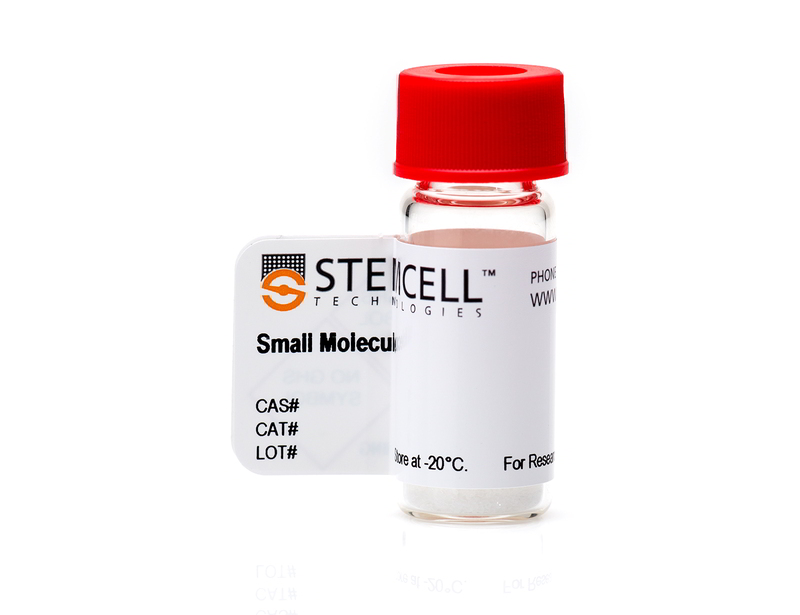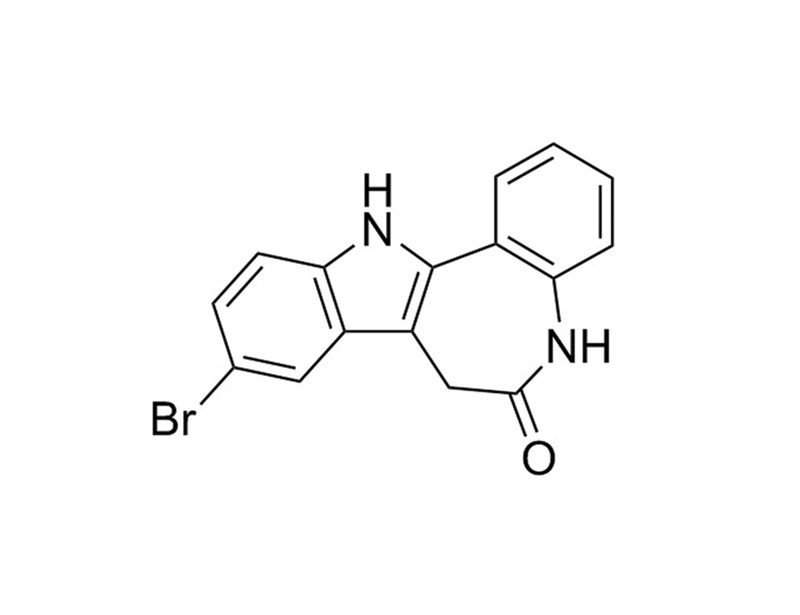概要
Kenpaullone is an ATP-competitive inhibitor of glycogen synthase kinase 3β (GSK-3β; Bain et al.; Leclerc et al.; Zaharevitz et al.). It inhibits GSK-3β, Cdk1/cyclin B, Cdk2/cyclin A, Cdk5/p25, and lymphocyte kinase with IC₅₀ values of 0.23, 0.4, 0.68, 0.85, and 0.47 µM, respectively (Bain et al.; Zaharevitz et al.).
REPROGRAMMING
· Replaces Klf4 in the generation of induced pluripotent stem (iPS) cells from mouse embryonic fibroblasts (MEFs) transduced with Oct4, Sox2, and c-Myc (Lyssiotis et al.).
DIFFERENTIATION
· Enhances neuronal differentiation in rat and human neural precursor cell cultures (Castelo-Branco et al.; Lange et al.).
· Promotes survival of motor neurons derived from mouse embryonic stem (ES) cells and from Amyotrophic Lateral Sclerosis (ALS) patient iPS cells (Yang et al.).
CANCER RESEARCH
· Inhibits KLF4 expression and self-renewal in breast cancer stem cells in vitro (Yu et al.).
REPROGRAMMING
· Replaces Klf4 in the generation of induced pluripotent stem (iPS) cells from mouse embryonic fibroblasts (MEFs) transduced with Oct4, Sox2, and c-Myc (Lyssiotis et al.).
DIFFERENTIATION
· Enhances neuronal differentiation in rat and human neural precursor cell cultures (Castelo-Branco et al.; Lange et al.).
· Promotes survival of motor neurons derived from mouse embryonic stem (ES) cells and from Amyotrophic Lateral Sclerosis (ALS) patient iPS cells (Yang et al.).
CANCER RESEARCH
· Inhibits KLF4 expression and self-renewal in breast cancer stem cells in vitro (Yu et al.).
技术资料
| Document Type | 产品名称 | Catalog # | Lot # | 语言 |
|---|---|---|---|---|
| Product Information Sheet | Kenpaullone | 72782 | All | English |
| Safety Data Sheet | Kenpaullone | 72782 | All | English |
数据及文献
Publications (8)
Cell stem cell 2013 JUN
A small molecule screen in stem-cell-derived motor neurons identifies a kinase inhibitor as a candidate therapeutic for ALS.
Abstract
Abstract
Amyotrophic lateral sclerosis (ALS) is a rapidly progressing neurodegenerative disease, characterized by motor neuron (MN) death, for which there are no truly effective treatments. Here, we describe a new small molecule survival screen carried out using MNs from both wild-type and mutant SOD1 mouse embryonic stem cells. Among the hits we found, kenpaullone had a particularly impressive ability to prolong the healthy survival of both types of MNs that can be attributed to its dual inhibition of GSK-3 and HGK kinases. Furthermore, kenpaullone also strongly improved the survival of human MNs derived from ALS-patient-induced pluripotent stem cells and was more active than either of two compounds, olesoxime and dexpramipexole, that recently failed in ALS clinical trials. Our studies demonstrate the value of a stem cell approach to drug discovery and point to a new paradigm for identification and preclinical testing of future ALS therapeutics.
Oncogene 2011 MAY
Kruppel-like factor 4 (KLF4) is required for maintenance of breast cancer stem cells and for cell migration and invasion.
Abstract
Abstract
Kruppel-like factor 4 (KLF4) is highly expressed in more than 70% of breast cancers and functions as an oncogene. However, an exact mechanism by which KLF4 enhances tumorigenesis of breast cancer remains unknown. In this study, we show that KLF4 was highly expressed in cancer stem cell (CSC)-enriched populations in mouse primary mammary tumor and breast cancer cell lines. Knockdown of KLF4 in breast cancer cells (MCF-7 and MDA-MB-231) decreased the proportion of stem/progenitor cells as demonstrated by expression of stem cell surface markers such as aldehyde dehydrogenase 1, side population and by in vitro mammosphere assay. Consistently KLF4 overexpression led to an increase of the cancer stem cell population. KLF4 knockdown also suppressed cell migration and invasion in MCF-7 and MDA-MB-231 cells. Furthermore, knockdown of KLF4 reduced colony formation in vitro and inhibited tumorigenesis in immunocompromised non-obese diabetic/severe combined immunodeficiency mice, supporting an oncogenic role for KLF4 in breast cancer development. Further mechanistic studies revealed that the Notch signaling pathway was required for KLF4-mediated cell migration and invasion, but not for CSC maintenance. Taken together, our study provides evidence that KLF4 has a potent oncogenic role in mammary tumorigenesis likely by maintaining stem cell-like features and by promoting cell migration and invasion. Thus, targeting KLF4 may provide an effective therapeutic approach to suppress tumorigenicity in breast cancer.
Neuroscience letters 2011 JAN
Small molecule GSK-3 inhibitors increase neurogenesis of human neural progenitor cells.
Abstract
Abstract
Human neural progenitor cells provide a source for cell replacement therapy to treat neurodegenerative diseases. Therefore, there is great interest in mechanisms and tools to direct the fate of multipotent progenitor cells during their differentiation to increase the yield of a desired cell type. We tested small molecule inhibitors of glycogen synthase kinase-3 (GSK-3) for their functionality and their influence on neurogenesis using the human neural progenitor cell line ReNcell VM. Here we report the enhancement of neurogenesis of human neural progenitor cells by treatment with GSK-3 inhibitors. We tested different small molecule inhibitors of GSK-3 i.e. LiCl, sodium-valproate, kenpaullone, indirubin-3-monoxime and SB-216763 for their ability to inhibit GSK-3 in human neural progenitor cells. The highest in situ GSK-3 inhibitory effect of the drugs was found for kenpaullone and SB-216763. Accordingly, kenpaullone and SB-216763 were the only drugs tested in this study to stimulate the Wnt/β-catenin pathway that is antagonized by GSK-3. Analysis of human neural progenitor differentiation revealed an augmentation of neurogenesis by SB-216763 and kenpaullone, without changing cell cycle exit or cell survival. Small molecule inhibitors of GSK-3 enhance neurogenesis of human neural progenitor cells and may be used to direct the differentiation of neural stem and progenitor cells in therapeutic applications.
Proceedings of the National Academy of Sciences of the United States of America 2009 JUN
Reprogramming of murine fibroblasts to induced pluripotent stem cells with chemical complementation of Klf4.
Abstract
Abstract
Ectopic expression of defined transcription factors can reprogram somatic cells to induced pluripotent stem (iPS) cells, but the utility of iPS cells is hampered by the use of viral delivery systems. Small molecules offer an alternative to replace virally transduced transcription factors with chemical signaling cues responsible for reprogramming. In this report we describe a small-molecule screening platform applied to identify compounds that functionally replace the reprogramming factor Klf4. A series of small-molecule scaffolds were identified that activate Nanog expression in mouse fibroblasts transduced with a subset of reprogramming factors lacking Klf4. Application of one such molecule, kenpaullone, in lieu of Klf4 gave rise to iPS cells that are indistinguishable from murine embryonic stem cells. This experimental platform can be used to screen large chemical libraries in search of novel compounds to replace the reprogramming factors that induce pluripotency. Ultimately, such compounds may provide mechanistic insight into the reprogramming process.
Journal of cell science 2004 NOV
GSK-3beta inhibition/beta-catenin stabilization in ventral midbrain precursors increases differentiation into dopamine neurons.
Abstract
Abstract
Wnts are important regulators of dopamine (DA) neuron differentiation in the developing ventral mesencephalon and could thus serve as potential tools in the treatment of Parkinson's disease. In this study, we investigate whether established intracellular Wnt signalling components could modulate the development of DA neurons. Two chemical inhibitors of glycogen synthase kinase (GSK)-3beta, indirubin-3-monoxime and kenpaullone, were found to increase neuronal differentiation in ventral mesencephalon precursor cultures. In addition, the GSK-3beta-specific inhibitor kenpaullone increased the size of the DA neuron population through conversion of precursors expressing the orphan nuclear receptor-related factor 1 into tyrosine hydroxylase positive neurons, thereby mimicking an effect of Wnts. We show that GSK-3beta inhibitors stabilized beta-catenin and that overexpression of beta-catenin in ventral mesencephalic precursors resulted in increased DA differentiation. The three- to fivefold increase in DA differentiation of precursor cells by GSK-3beta inhibitors suggests that such compounds could be used to improve stem/precursor cell therapy approaches in Parkinson's disease.
The Biochemical journal 2003 APR
The specificities of protein kinase inhibitors: an update.
Abstract
Abstract
We have previously examined the specificities of 28 commercially available compounds, reported to be relatively selective inhibitors of particular serine/threonine-specific protein kinases [Davies, Reddy, Caivano and Cohen (2000) Biochem. J. 351, 95-105]. In the present study, we have extended this analysis to a further 14 compounds. Of these, indirubin-3'-monoxime, SP 600125, KT 5823 and ML-9 were found to inhibit a number of protein kinases and conclusions drawn from their use in cell-based assays are likely to be erroneous. Kenpaullone, Alsterpaullone, Purvalanol, Roscovitine, pyrazolopyrimidine 1 (PP1), PP2 and ML-7 were more specific, but still inhibited two or more protein kinases with similar potency. Our results suggest that the combined use of Roscovitine and Kenpaullone may be useful for identifying substrates and physiological roles of cyclin-dependent protein kinases, whereas the combined use of Kenpaullone and LiCl may be useful for identifying substrates and physiological roles of glycogen synthase kinase 3. The combined use of SU 6656 and either PP1 or PP2 may be useful for identifying substrates of Src family members. Epigallocatechin 3-gallate, one of the main polyphenolic constituents of tea, inhibited two of the 28 protein kinases in the panel, dual-specificity, tyrosine-phosphorylated and regulated kinase 1A (DYRK1A; IC(50)=0.33 microM) and p38-regulated/activated kinase (PRAK; IC(50)=1.0 microM).

 网站首页
网站首页




